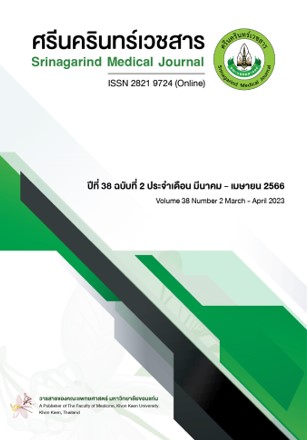Damage of Biological Evidences in Sexual Assault Cases: A Hospital-Based Study
Keywords:
Sexual assault, physical evidence, cotton swab, fungal contamination, physical evidence preservationAbstract
Background and objective : Semen stains are the biological evidence that is important for charging individuals with sexual offenses because, for investigative purposes, there are used to verify the relationship between the offender and the victim. Therefore, the preservation and delivery of this type of physical evidence for examination is very important. The poor preservation of semen stains, including improper delivery, may affect the quality of the physical evidence and thus, may further affect additional forensic laboratory testing. This study aimed at examining the patterns of damage of specimens from sexual assault cases that can occur during storage and delivery.
Method :.The data was collected from the submission form of the specimens in sexual assault cases and the records from the receipt of physical evidence at the Laboratory of the Department of Forensic Medicine at the Faculty of Medicine at Khon Kaen University. The specimens, which were investigated, had been delivered from hospitals in the Northeast from 1 March 2011 to 31 August 2016. Analyzing the statistical relationship by binary logistic regression.
Result : The majority were cotton swabs at 97.64 percent (3,929 / 4,024), and the remaining samples consisted of glass slides at 2.36 percent (95 / 4,024). However, it was found that 1.68% (66 / 3,929) of the cotton swabs, which had been sent for examination, had been damaged by fungal contamination. In addition, every day that the period of testing was extended was found to have resulted in significantly increased fungal contamination by 1.09 times (p<0.05). Moreover, 8.42% (8/95) of the glass slides had been broken.
Conclusion : The pre-delivery process and the timely delivery of the specimens are both important. In addition, with poor preservation and slow delivery, the physical evidence, which is required for the sexual assault cases, can be damaged.
References
Trangkasombat U. Sexual abuse in Thai children: a qualitative study. J Med Assoc Thai 2008;91(9):1461-7.
Suthapom S, Teerapong S, Aojanepong T, Sangviroon A, Napakorn K, Bhamarapravatana K. Characteristics and health consequences of adolescent sexual assault at Police General Hospital, Thailand. J Med Assoc Thai 2014;97(12):1221-6.
Kamenev L, Leclercq M, Francois-Gerard C. Detection of p30 antigen in sexual assault case material. J Forensic Sci Soc. 1990;30(4):193-200. doi.org/10.1016/S0015-7368(90)73339-7
Suttipasit P. Forensic Spermatozoa Detection. Am J Forensic Med Pathol. 2019;40(4):304-11. doi.org/10.1097/PAF.0000000000000517
Goldacre MJ, Watt B, Loudon N, Milne LJ, Loudon JD, Vessey MP. Vaginal microbial flora in normal young women. Br Med J. 1979;1(6176):1450-3. doi.org/10.1136/bmj.1.6176.1450
Maccato ML, Kaufman RH. Fungal vulvovaginitis. Curr Opin Obstet Gynecol. 1991;3(6):849-52. doi.org/10.1097/00001703-199112000-00018
de Oliveira JM, Cruz AS, Fonseca AF, Vaz CP, Rodrigues A, Aurea F, et al. Prevalence of Candida albicans in vaginal fluid of asymptomatic Portuguese women. J Reprod Med 1993;38(1):41-2.
Ahmad A, Khan AU. Prevalence of Candida species and potential risk factors for vulvovaginal candidiasis in Aligarh, India. Eur J Obstet Gynecol Reprod Biol. 2009;144(1):68-71. 1. doi.org/10.1016/j.ejogrb.2008.12.020
Hammerschlag MR, Alpert S, Rosner I, Thurston P, Semine D, McComb D, et al. Microbiology of the vagina in children: normal and potentially pathogenic organisms. Pediatrics. 1978;62(1):57-62. doi.org/10.1542/peds.62.1.57
Johnson SR, Petzold CR, Galask RP. Qualitative and quantitative changes of the vaginal microbial flora during the menstrual cycle. Am J Reprod Immunol Microbiol. 1985;9(1):1-5. doi.org/10.1111/j.1600-0897.1985.tb00331.x
Wilks M, Tabaqchali S. Quantitative bacteriology of the vaginal flora during the menstrual cycle. J Med Microbiol. 1987;24(3):241-5. doi.org/10.1099/00222615-24-3-241
Yaniz JL, Vicente-Fiel S, Soler C, Recreo P, Carretero T, Bono A, et al. Comparison of different statistical approaches to evaluate morphometric sperm subpopulations in men. Asian J Androl. 2016;18(6):819-23. doi.org/10.4103/1008-682X.186872
Shaaban OM, Abbas AM, Moharram AM, Farhan MM, Hassanen IH. Does vaginal douching affect the type of candidal vulvovaginal infection? Med Mycol. 2015;53(8):817-27. doi.org/10.1093/mmy/myv042
Downloads
Published
How to Cite
Issue
Section
License
Copyright (c) 2023 Srinagarind Medical Journal

This work is licensed under a Creative Commons Attribution-NonCommercial-NoDerivatives 4.0 International License.




